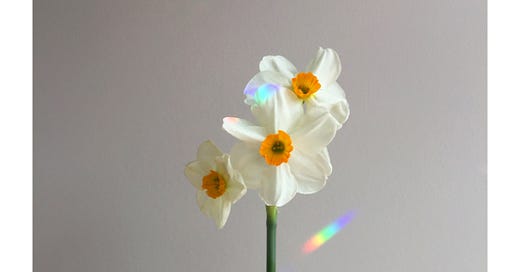At last, a landscape washed dull from winter rains dazzles with the radiant faces of daffodils. Their long, slender necks bend, following the sun’s generous arc across the sky, transmuting their papery tepals into solid gold. They cry out to us: Winter is over! Their hue rouses us and all creatures from our long slumber. They may not speak, but their color does.
The word yellow comes to us from the Proto-Germanic gelwaz. Its Indo-European root, gel-—which it shares with gold and yell—gives us a glimpse of how the ancients might have felt upon seeing this plant. They, too, must have welcomed its proclamation.
Yellow is an abundant color in nature, and it is also a color of abundance. And of transition. In the fall, just before trees disrobe for winter, chlorophyll, the pigment that gives plants their green color, diminishes. Red and yellow pigments, called carotenoids, take over, and the foliage erupts into flames. In spring, a banner of yellow returns: forsythia, crocuses, and daffodils dot the landscape. I resist the temptation to pick anything. Winter was hard, but I want to savor its end, to remember all that we endured together.
Eventually, when enough daffodils have bloomed, I do cut a fistful. I planted bulbs in November just to have some for myself, each scoop of the trowel making room for hope to grow. Please bring the light, I plead to the bulbs as I cover them with dirt, as darkness begins to blanket the earth. Four months later, I feel gratitude. They have bloomed, and with their sunshine there is a sense that goodness will triumph. I pull out my garden shears and they offer their necks to me, a sacrifice on my altar of hope.
I leave the nine stems long and arrange them in a discarded brown medicine bottle, then place it by the window. I have been waiting for this moment. At sunset, light filters through their tepals like stained glass. My living room becomes a chapel. I am transported to St. Non, the ruined chapel near the Pembrokeshire Coast Path, where in the 5th century AD, a young girl named Nonna gave birth to St. David, the patron saint of Wales. Outside, there is a holy well with consecrated spring water, and I imagine all the daffodils—Wales’ national flower—that draw from its source like its pilgrims do throughout the year.
Unlike the quiet elegance of crocuses or snowdrops, the daffodil is not a natural beauty. Oddly proportioned, its ruffled corona juts perpendicularly from the tepals—the “petals” that frame it—like an afterthought. Except every cell in my being points to intention. I imagine a playful Creator, one who, like me, delights in a good cut-and-paste session, layering together two of their favorite flowers. Weirdness is beauty!, it seems to trumpet.
By the weekend, the blooms have begun to fade. The house is too dry; they long for the steady drip of spring rain. Shriveled tepals retreat to the base of the corona, and it seems a new flower has morphed before my eyes—one that could be a cousin to the tulip. My own tulips still sleep in their beds. Their gray-green leaves emerged in February, but it will be weeks before I see their faces.
I accept that these daffodils are dying. I do not look up how to extend their life, but I change their water. It seems the good thing to do. Compared to the grandmother cedar I met in January, they have seen less of the visible world, but they carry secrets I will never know. Through self-propagation, something I cannot do, they will outlive me. This is not a plant to be underestimated. Even as their faces wither, even as their color fades, their stems remain stick-strong.
As I grow old, may I be as the daffodil.





You draw so much wisdom and beauty from nature. You keep me lookin closer.
Hail Harbinger of Spring!